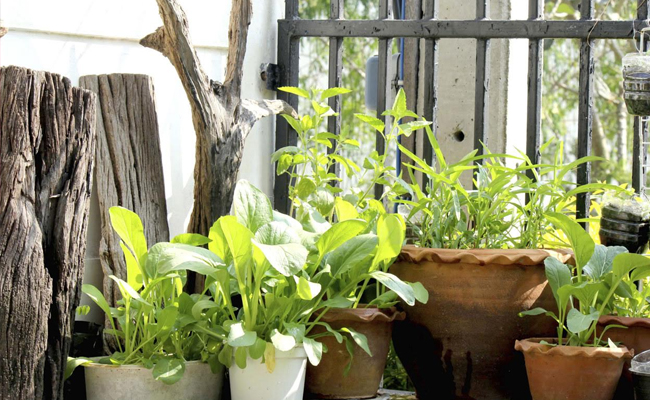The Beginner's Guide to Grow Plants
You all would agree with us without batting an eyelid that modern life is physically, mentally, and emotionally taxing. Between the looming office deadlines and updating our personal stories, we tend to lose our sanity. But, it’s never too late to work for yourself. “Kyunki jaan hai toh jahan hai.” If you are thinking we will be advising you to exercise, eat healthy, meditate, then you are not wrong because you should indulge in healthy habits, but we are going to suggest you grow plants.
And, we have a plausible reason for advocating plant growth. Pieces of scientific researches have revealed that puttering around with your green buddies can have a profoundly uplifting effect on the body, mind, and soul. The benefits may be intangible, but they are definitely present. Besides the health advantages, having plants is a sure way to embrace beautiful surroundings and fresh environs. Just in case a desire to hone your green thumbs develop in your heart, and you start looking for how to plant, we have prepared for you a beginner’s guide to growing plants.

We love when people get excited about planting, and therefore, we have listed down all the steps of how to plant a plant so that you can nurture and nourish the seeds of a brighter and better future.
Grab your paper and pen, carefully note down all the steps, and make way for green and healthy tomorrow.
The Essential Requirements For Seed Germination
Light: Light is the necessary fuel for plant growth. The emerald green leaves of the plant are giant solar panels, which through phototaxis move towards the sun for capturing as much sunlight as they require. Keep the light considerations in mind before choosing a spot for the plants.
Water: You need water to survive, and so do the plants. Water is important for plants physiological purposes, including growth and metabolism. Once you sow the seeds of a particular plant, go through the water requirement of the plant. Dessert-loving plants like succulents require less watering, whereas the Feng Shui Bamboo plant requires frequent watering.
Air: Fresh air and ventilation are often neglected when taking care of the plants, but it is necessary. Plants love fresh air as that is essential for the plant to exhale and transpire. Airflow is responsible for wicking away moisture that keeps the plant happy and healthy.
Let’s grow plants!
Step 1: Get Containers: To sow seeds, you will need containers. Either you can use butter tray, cookie tin or you can shop online planters in varying materials and designs. Some of the popular ones being concrete vases, metal containers, terracotta vases, and more. For adding a touch of beauty and grace to your surroundings, look for pots in pretty colours, glass containers with colourful pebbles, resins pots in the silhouette of giraffes, dogs, etc. Always shop containers with holes that allow water to drain; otherwise it will make the seed compost overly wet. If you are using leftover trays as containers, dig holes at the bottom.

Step 2: Fill the Container with Seed Compost: Sterile seed compost is recommended. You can also use potting soil available in nurseries. Don’t use soil dug from the garden because it is lumpy, contains weeds, and it's too heavy. Use proper soil compost, wet the soil with warm water and fill the container with the soil.

Step 3: Plant At Proper Depth: Fill the container with the soil compost and moisten the surface with a mist spray. Plant the seeds at the proper depth. You can find the optimal planting depth on the packet of the compost. The green thumb rule is to cover the seeds with the soil equal to three times their thickness. Some seeds require light for germination; therefore, they should be spread evenly on the surface.

Step 4: Maintain Moisture: Maintaining consistent moisture is very crucial. Buy plastic or wooden covers from a nursery offering gardening tools online. Cover the container with the covering to lock moisture.

Step 5: Place The Seed Tray In A Warm Place: Seeds need warm soil to germinate. Seeds germinate at a slow rate or not at all in soil that is not warm. You can buy waterproof heating mats that are designed to germinate the seeds or place the container with seeds at a warm spot.

Step 6: Uncover the Container: Once the seeds germinate, you must uncover the container. Expose the seedling to light, keep the soil moist, and fertilize the seeds with organic liquid fertilizer. Remember, we told you light, water, air are essential for the seeds to grow. Never forget that. Keep the pot in a location where there is sunlight and air flow. Also, make sure the seeds are not dislodged from the soil while fertilizing.

Step 7: Hardening Off: Plants that have been grown indoors need to be hardened off for a period of about 7 to 10 days. Hardening off is the procedure to make the plants acclimatized to newer and harsh environments. Plants can be hardened off by exposing them to new conditions for an hour, and gradually extending the time.

And, if you found this beginner guide on how to start a garden from scratch helpful, do share with your friends and family.
Happy Gardening!!















